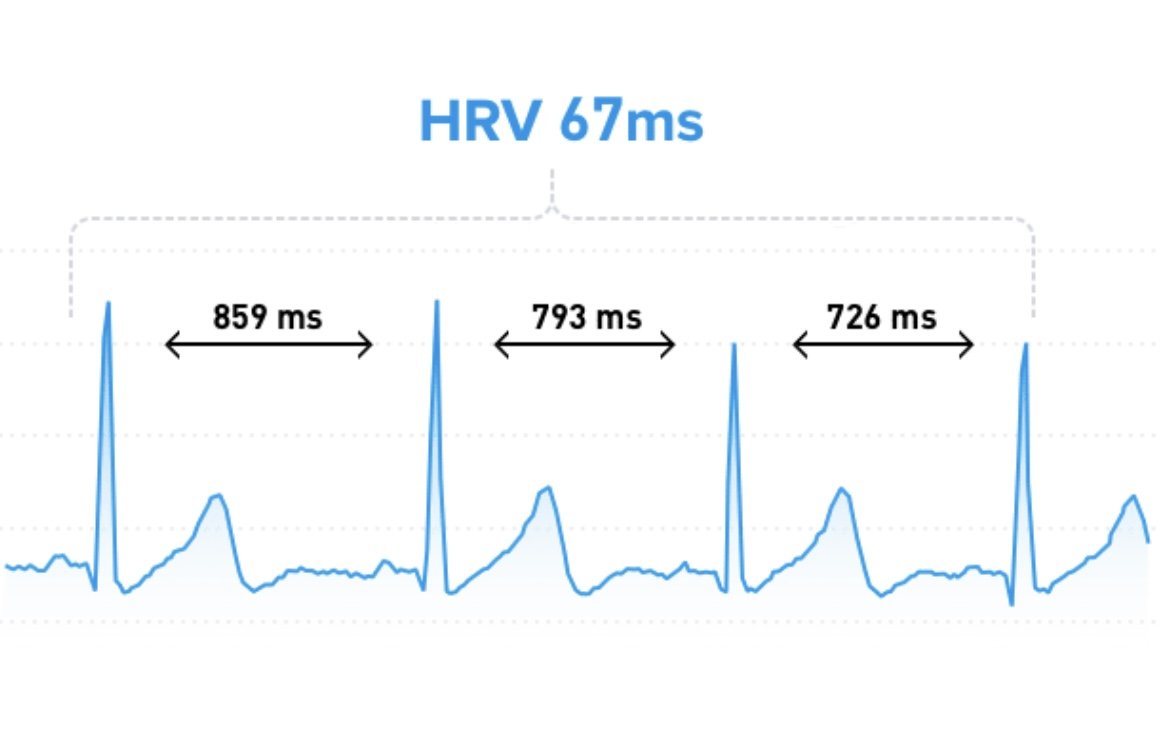Heart Rate Variability (HRV)?
Heart Rate Variability (HRV)
Heart rate variability (HRV) measures the variance in time between your heartbeats while you are asleep. It is a great indicator of how well your body can adapt to its environment and perform. In general, a higher HRV signals better fitness.
This is a very individualized metric that is different for everyone. Several factors can impact your HRV such as: Age, gender, lifestyle and fitness. Rather than comparing yourself to others, compare your HRV to your baseline values over time.
What is Heart Rate Variability (HRV)?
Heart rate variability is determined by the time between heart beats, known as RR intervals. So, if your heart rate is 60 beats per minute, it's not actually beating once every second. Within that minute there may be 0.9 seconds between two beats, for example, and 1.15 seconds between two others. The greater this variability is, the more "ready" your body is to execute at a high level.
These periods of time between successive heart beats are known as RR intervals (named for the heartbeat's R-phase, the spikes you see on an EKG), measured in milliseconds.
HRV And The Autonomic Nervous System
Although HRV manifests as a function of your heart rate, it actually originates from your nervous system. Your autonomic nervous system, which controls the involuntary aspects of your physiology, has two branches, parasympathetic (deactivating) and sympathetic (activating).
The parasympathetic nervous system (often referred to as "rest and digest*) handles inputs from internal organs, like digestion or your fingernails and hair growing. It causes a decrease in heart rate.
The sympathetic nervous system (often called "fight or flight) reflects responses to things like stress and exercise, and increases your heart rate and blood pressure.
Heart rate variability comes from these two competing branches simultaneously sending signals to your heart. If your nervous system is balanced, your heart is constantly being told to beat slower by your parasympathetic system, and beat faster by your sympathetic system. This causes a fluctuation in your heart rate: HRV.
Why is HRV a Sign of Fitness?
When you have high heart rate variability, it means that your body is responsive to both sets of inputs (parasympathetic and sympathetic). This is a sign that your nervous system is balanced, and that your body is very capable of adapting to its environment and performing at its best.
On the other hand, if you have low heart rate variability, one branch is dominating (usually the sympathetic) and sending stronger signals to your heart than the other. There are times when this is a good thing-like if you're running a race you want your body to focus on allocating resources to your legs (sympathetic activity) as opposed to digesting food (parasympathetic activity).
However, if you're not doing something active low HRV indicates your body is working hard for some other reason (maybe you're fatigued, dehydrated, stressed, or sick and need to recover), which leaves fewer resources available to dedicate towards exercising, competing, giving a presentation at work, etc.
The less one branch is dominating the other, the more room there is for the sympathetic (activating) branch to be able to come in and dominate, which is why high HRV suggests you're fit and ready to go.
Is it better to have high or low HRV?
In general, a higher heart rate variability (HRV) is considered better as it indicates a more adaptable and resilient autonomic nervous system, which can respond effectively to different stressors. Conversely, a low HRV may be associated with an increased risk for various health problems, such as cardiovascular disease, depression, and anxiety.


